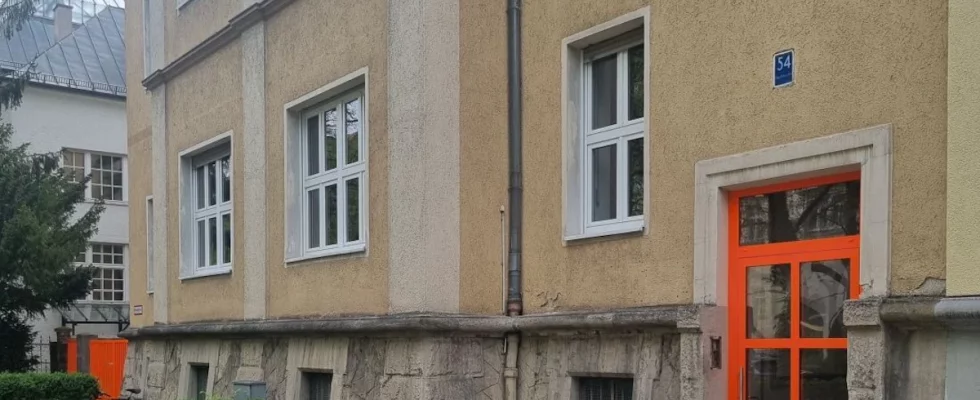The museum director sits in a room in the former caretaker’s apartment with a view of the inner courtyard. Where the bathroom once was, boxes are piled up, office supplies are stored, and the printer is located. The employees are spread across all floors, as are the exhibition rooms. Several days before work is scheduled to begin in the interim quarters of Villa Stuck on Goethestrasse, craftsmen are still busy everywhere, sawing, hammering, drilling and screwing. It’s like a dovecote, which is stoically watched over by a supervisory staff member who also moved with us. And the director?
Michael Buhrs doesn’t seem unhappy. “It was a real hussar ride, because we only had three months for planning, the structural changes and researching the projects with which we want to fill VS with life. But I’m glad that we found alternative accommodation so quickly, in which exhibitions, art education and staff are accommodated together,” emphasizes the director of Villa Stuck, which recently closed for renovation. If you know other cases of renovation in Munich, such as the Neue Pinakothek or the City Museum, where staff and exhibition facilities – if available at all – are spread across different buildings and sometimes across different city districts, you understand Buhrs’ relief even more.
However, these are really major construction sites, whereas Villa Stuck only has to move out for an interlude. So far there has been talk of a renovation period of one and a half years. The rental agreement for Goethestrasse 54 runs for one year until April 30, 2025. And Michael Buhrs is confident that it can be done within this time – “maybe even quickly,” he says.
The fact that VS can now use this house with 450 square meters on three floors and an 80 square meter rear building as interim quarters also has to do with the secretary of the Villa Stuck support association, the real estate developer James Legat. “The city didn’t have anything available. But James said they had a new property where nothing was currently happening. And the rent was below the usual average. So we took it.” And first of all, the frame of the entrance door was painted bright orange to draw attention to itself. “RAL 2005 – everyone in the house now knows the color number,” smiles Buhrs.

According to Buhrs, the investments in the interim project VS amounted to 150,000 euros. The money was invested in a few structural changes, but primarily in fire protection, electrical systems and technology. Getting connected to the city’s Wi-Fi inexpensively in such a short space of time seems to have been a challenge if you interpret Buhrs’ words correctly. “But we found a solution,” he cheers. There will also be free WiFi for visitors. In addition, “a lot of convincing work” was done to allow free entry to the exhibitions and events.
Buhrs doesn’t dispute the fact that you no longer live on the stately Prinzregentenstrasse – at least from the city center – but instead sit between the train station district and the clinic district, the Oktoberfest and Nußbaumpark. On the contrary. He and his team see it as an opportunity. Showing the collection would not have been possible for climate and safety reasons. So they developed a completely different program. A “community manager” is out in the area to make contacts and spread the word about VS. Joint projects are to follow. On each floor, the central room is open as a place to stay and meet. On the ground floor there is a film room, a reading room and an education room.

The first projects already deal with the “Congenial Neighbors”, as is the title of one of the exhibitions: The focus is on the New Anatomy, which the well-known architect Max Littmann built at the beginning of the 20th century and which is now part of the LMU, as well the former Kunsthaus Brakl by Emanuel von Seidl, which is now used as a medical reading room. It will also be about the history of the house at Goethestrasse 54 itself. The exhibition “What Happened So Far” discusses the employment of forced laborers during the Nazi era at the Geha-Werke, which had its offices here at the time. Jewish fellow citizens who had been forcibly dispossessed were accommodated on the ground floor, where the Pension Patria was located, on the way to deportation. In the 1980s, the Rinascita association was based in the back building, which looked after Italian migrant workers but also offered a political and cultural program.
And finally, there will also be a “Library of Artistic Print on Demand”, where three libraries will take turns as guests. All of these exhibitions begin with the opening weekend, which starts on Friday, May 3rd at 4 p.m. and continues on May 4th and 5th from 12 p.m. to midnight.
Incidentally, some of the Villa stucco collection has been traveling to promote the museum. Twelve showpieces, including the “Sin”, the “Guardian of Paradise” and the “Artist’s Festival” were created Sofia to the National Gallery borrowed. They can be seen there until October together with “Lucifer” from the collection there, which is considered the most valuable painting in Bulgaria, in the exhibition “Franz von Stuck between Light and Darkness”. Further stations are being worked on. They should be back at the latest when we move from Goethe Street back to Prinzregentenstrasse and VS becomes Villa Stuck again.

